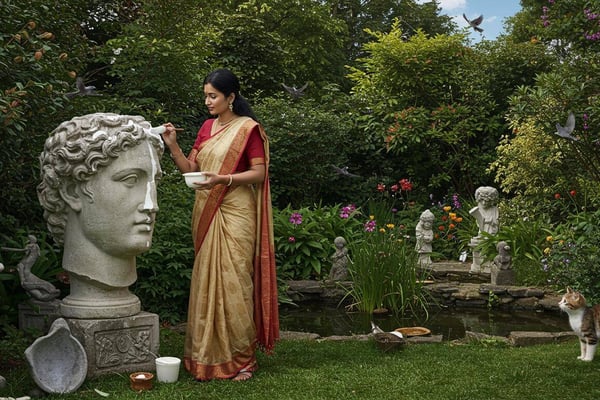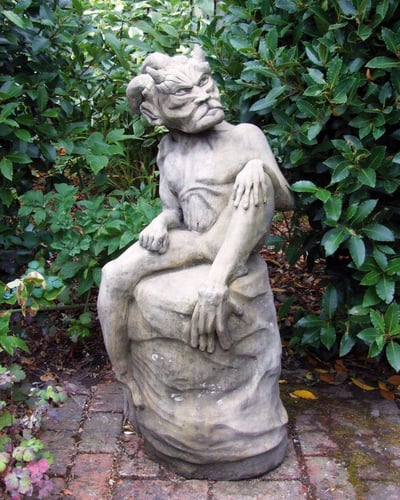How to Age a Garden Statue
Written by on 6th Mar 2025.
Key Takeaways
- Use yoghurt to naturally age garden statues (the live bacteria accelerates weathering)
- Mix black/grey acrylic paint with water for a base coat that creates an aged look
- Apply moss and soil to create authentic patina and encourage natural growth
- Place statues in shaded, damp areas to speed up the ageing process
- Different methods (yoghurt, buttermilk, compost) produce varying weathering effects
Most garden enthusiasts prefer the charm of weathered, aged garden ornaments over pristine ones. That lived-in, established look makes garden statues seem like they've always been part of your landscape. Let's explore proven methods to create that timeless patina on new garden statues.

Why Age Your Garden Statues?
New stone garden ornaments often look too clean and bright in an established garden. Ageing gives them character and helps them blend naturally with their surroundings. While you could wait years for nature to take its course, these methods will speed up the process substantially.

Garden statues have graced outdoor spaces for centuries. Modern versions are typically cast in artificial stone or concrete, replicating the appearance of hand-carved originals. These can be aged effectively with simple household ingredients.
The Yoghurt Method: Quick and Dramatic Results
The yoghurt method is popular because it's effective and surprisingly quick. The live bacteria in yoghurt (Lactobacillus bulgaricus and Streptococcus thermophilus) encourage bio-cultures to grow on stone, accelerating the weathering process.
Materials Needed:
- Natural yoghurt (Greek yoghurt works well)
- An old paintbrush
- Gloves
- Your garden statue
Step-by-Step Process:
- Using your paintbrush, liberally apply natural yoghurt all over the statue
- Pay extra attention to details and crevices where natural weathering would occur
- Keep the statue out of rain initially so the yoghurt doesn't wash off
- Place in a shaded area (especially important in warm weather)
What to Expect:
- Week 1: The statue may develop red spots and smell slightly (this is normal!)
- Week 3: The redness fades, replaced by developing patina
- Week 5: Significant transformation with lichen and moss beginning to appear

One gardener achieved remarkable results on a mythical beast statue, transforming it from bright white to Gothic-looking in just five weeks using a £1 tub of yoghurt. The statue appeared as if it had been in the garden for decades!
The Compost and Paint Method
This more comprehensive method combines several techniques for an authentic aged appearance.
Materials Needed:
- Black or dark grey acrylic (water-soluble) paint
- Natural yoghurt
- Garden soil, well-rotted manure, or compost
- Garden moss
- Large paintbrush
- Gloves
- Bucket and water
Step-by-Step Process:
- Mix paint with water to create a weak solution resembling dirty water
- Paint this solution onto the statue and allow to dry
- Repeat until you achieve your desired base colour
- In a bucket, mix equal parts yoghurt, water, and soil/manure/compost to create a thick paste
- Wearing gloves, coat the statue generously with this paste, focusing on recesses
- Rub handfuls of moss over the statue to spread spores
- Place the statue in a shaded, damp area to encourage moss growth

Alternative Methods for Weathering Stone
Buttermilk Method
A mixture of moss, buttermilk and water creates an excellent base for moss growth. Some artists use this for "moss graffiti." Adding water retention gel helps keep moisture in the moss.
Soil Submersion
Burying small ornaments in the ground or submerging them in muddy water before beginning the ageing process encourages natural weathering.
The Natural Environment Method
Simply placing your statue in strategic locations can dramatically affect how quickly it ages:
- Under trees or in bushes
- In damp, shady areas
- Near bird perches (birds will contribute to the ageing process!)
- Among thick borders or grasses

Enhancing Your Weathering Mixture
To create more diverse effects, consider these additions to your yoghurt or buttermilk mixture:
- Soil or silt for darker staining
- Muddy water for natural colouration
- Soot for dramatic dark patches
- Decaying leaves for organic texturing
Different mixtures produce varying effects. The yoghurt method tends to create the most dramatic transformation, while compost creates a more subtle effect, and soot gives a darker appearance.
Best Types of Statues for Ageing
While most stone garden ornaments can be aged successfully, some designs highlight weathering particularly well:
- Detailed Ornaments: Statues with intricate details like the Mythical Beast Statue show weathering beautifully as the details become accentuated.
- Classical Figures: Traditional Stone Garden Statues like Venus or Hercules look authentic when aged.
- Architectural Features: Gargoyles and Gothic pieces develop character when weathered.

Remember that only porous stone can be aged effectively. Cast stone and concrete work well, but glazed ceramics might not respond to these methods.
Practical Considerations
- Location: The placement of your statue greatly affects how quickly and effectively it ages.
- Timing: Weather affects the ageing process. In winter, some methods might take longer.
- Initial Appearance: Be patient through the "teenage years" of the process when the statue might look strange.
- Maintenance: Once you've started the ageing process, let nature take over. Additional treatments are rarely needed.
After establishing your statue in its location, it will continue to age naturally, becoming more integrated into your garden over time.
Why Choose Aged Garden Ornaments?
Aged Stone Garden Ornaments offer several advantages:
- They look established rather than newly placed
- They blend harmoniously with mature gardens
- They have more character and visual interest
- They match the patina of genuine antique garden elements
Sometimes, ageing is practical too. If you're replacing one element in a pair (like a damaged gate post), ageing helps the new piece match the original.

Frequently Asked Questions
Most statues show significant changes within 3-5 weeks using the yoghurt method, though results vary based on weather conditions and statue material.
No, these methods mimic natural weathering processes and won't damage stone or concrete statues. They're not suitable for metal ornaments.
The yoghurt method typically produces the most dramatic and fastest transformation.
There might be a temporary odour during the first week with the yoghurt method, but this dissipates quickly as the statue weathers.
These methods work best on porous materials like concrete, cast stone, and natural stone. They're less effective on metal, glazed ceramic, or plastic.
Initial applications might be affected by heavy rain. Consider sheltering new treatments for the first few days or reapplying if needed.
Once aged, let nature continue the process. No maintenance is required—the weathering will continue naturally over time.
While difficult to completely reverse, you can clean a statue with a pressure washer to remove some of the ageing effects.
By following these methods, you'll transform new garden ornaments into pieces that look like they've graced your garden for generations. The right amount of character and patina makes all the difference in creating a garden that feels established and thoughtfully cultivated.